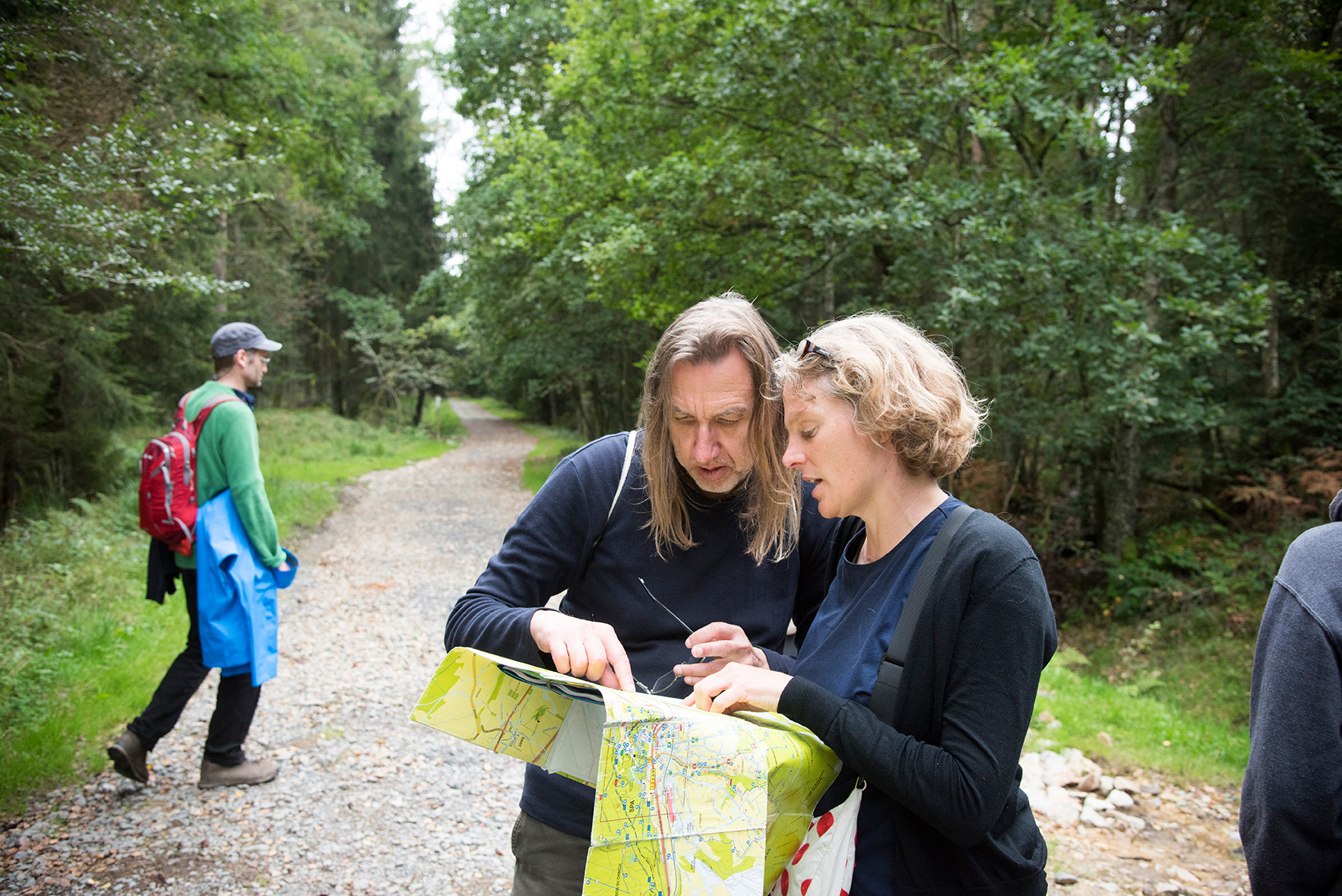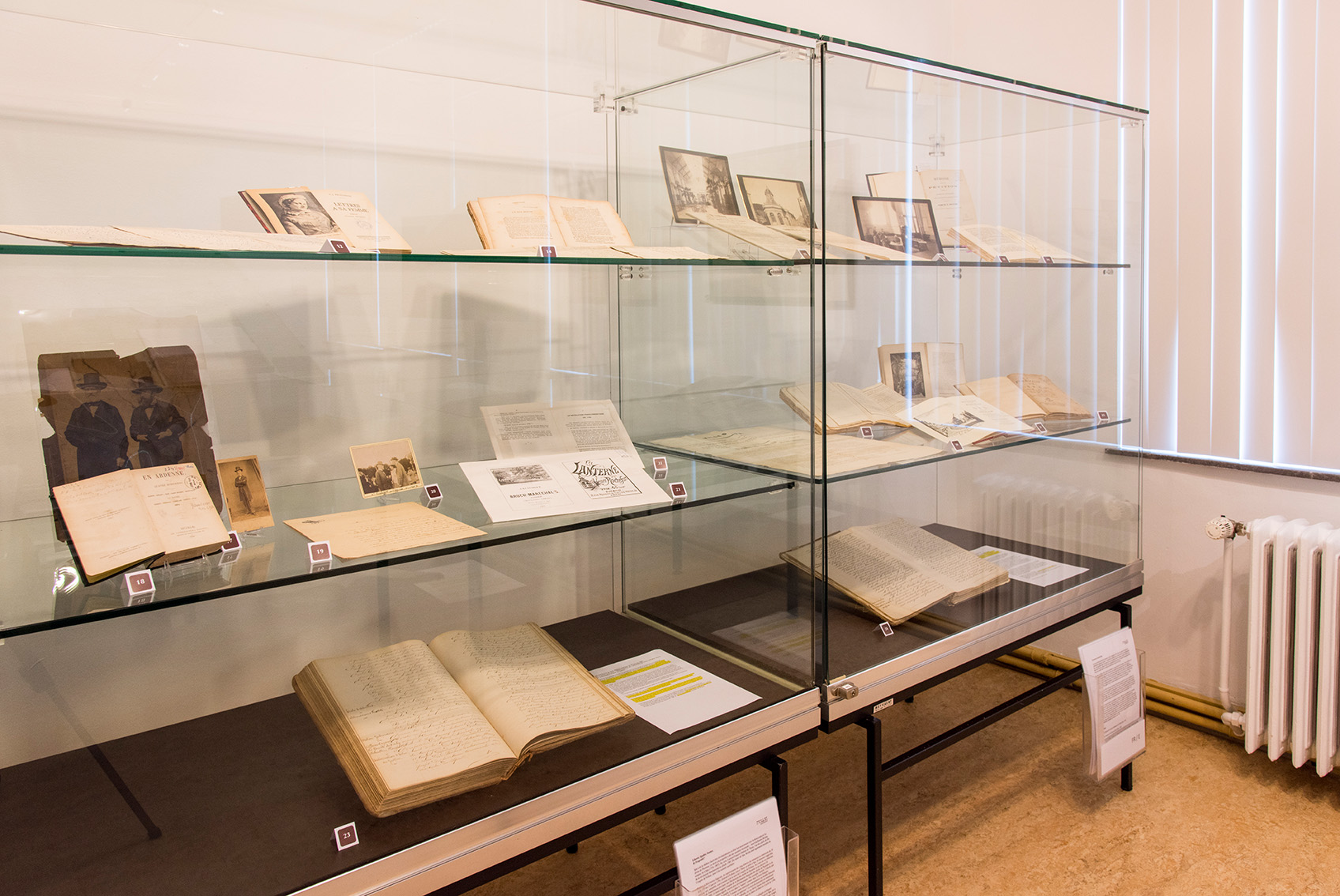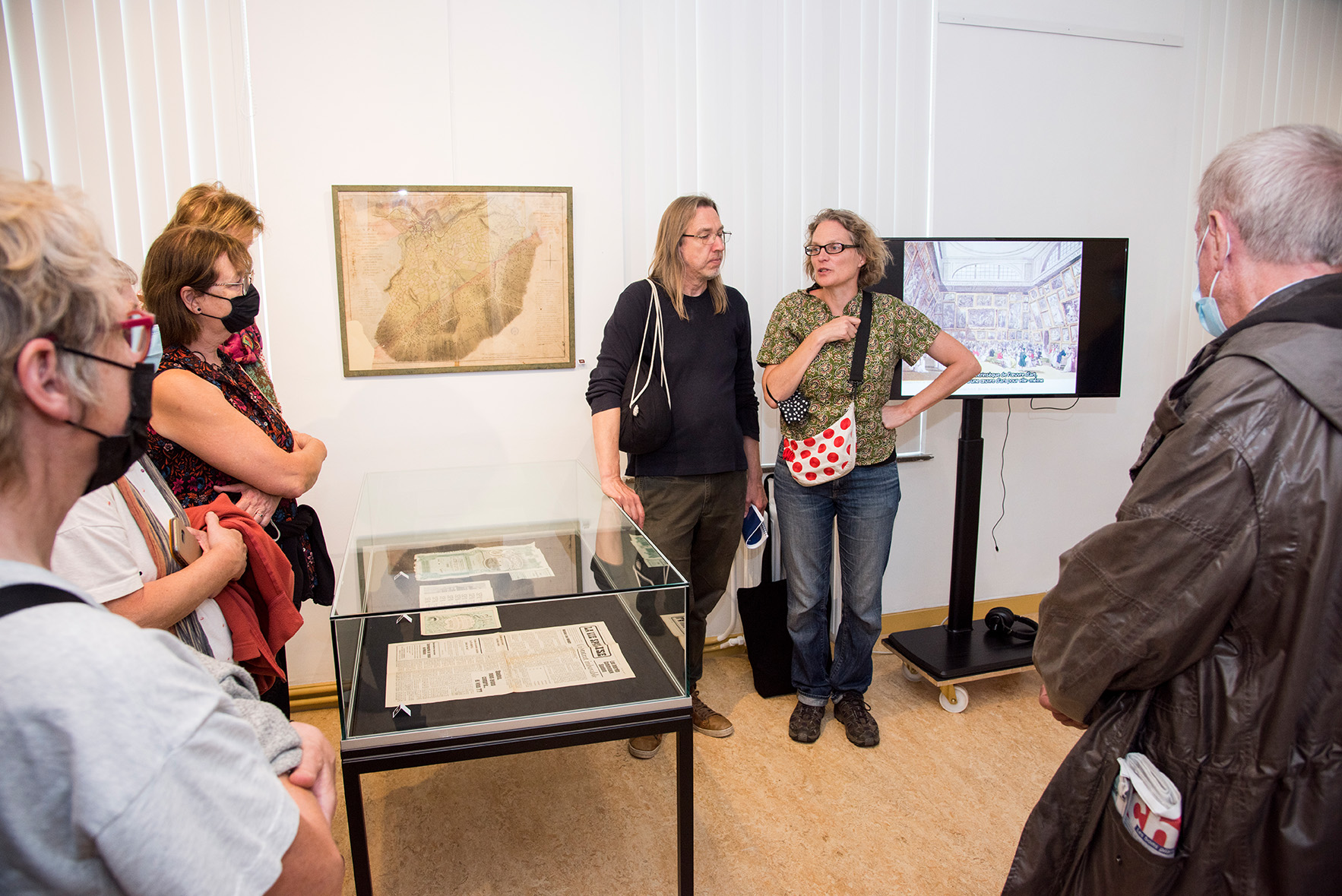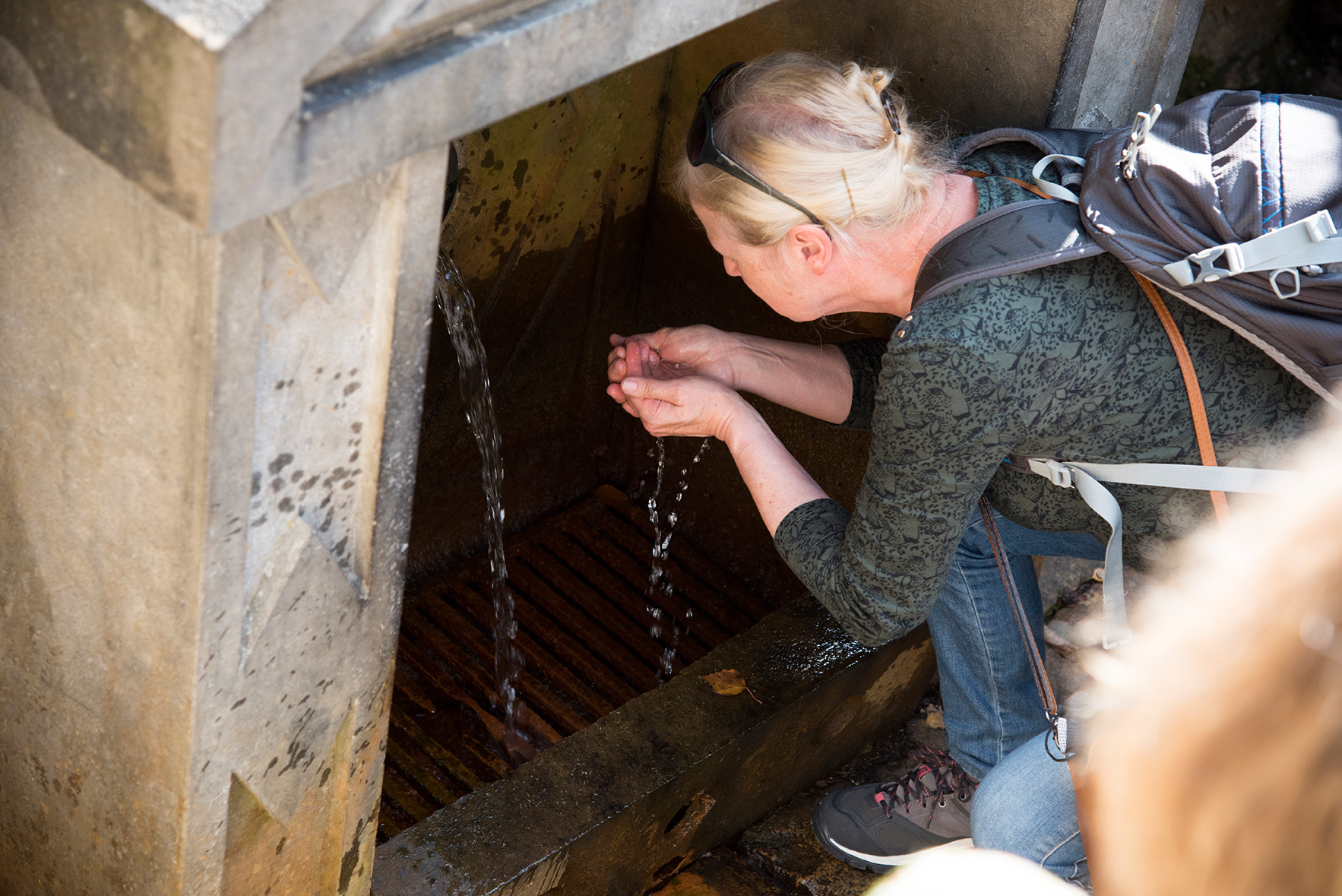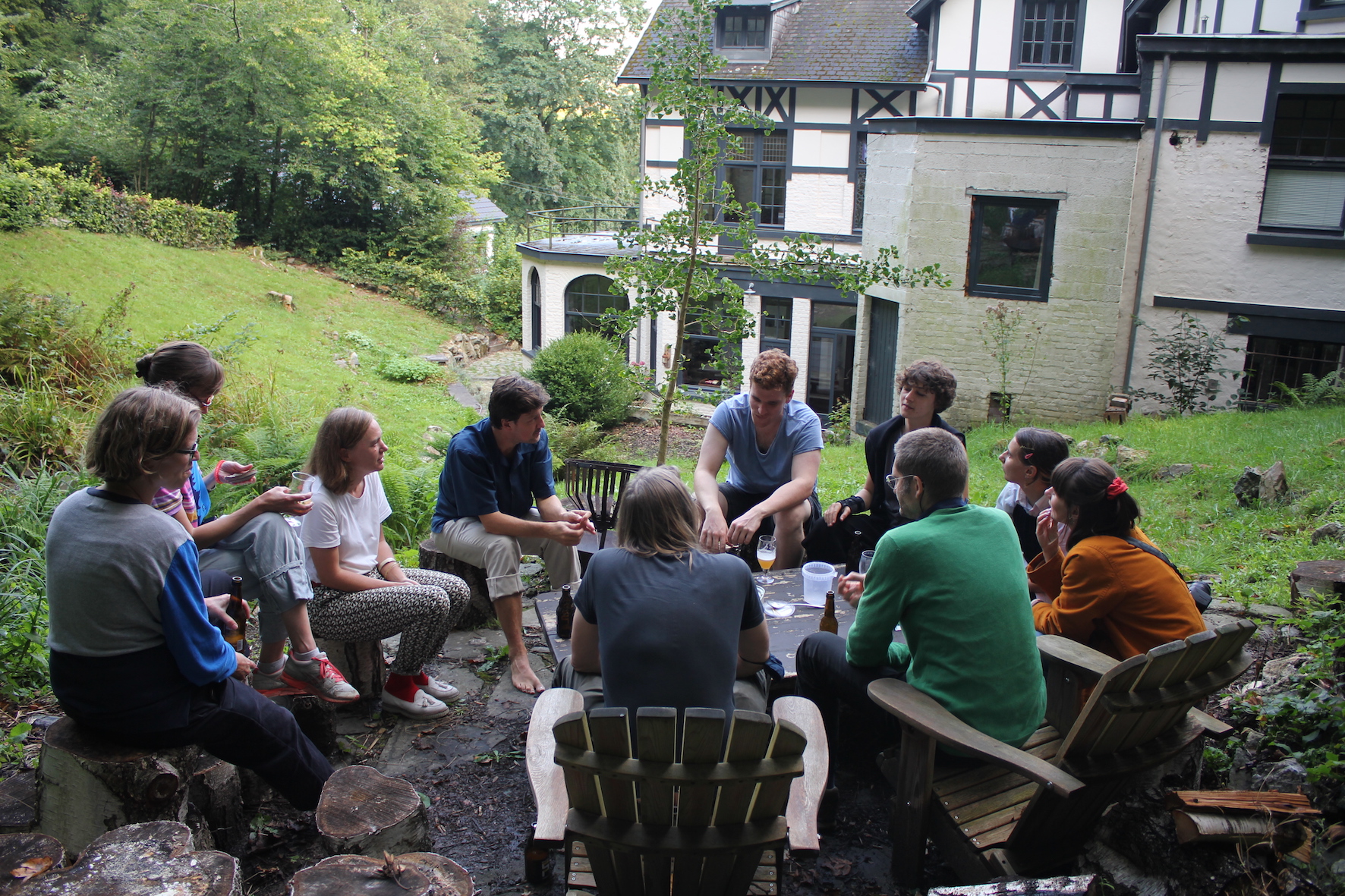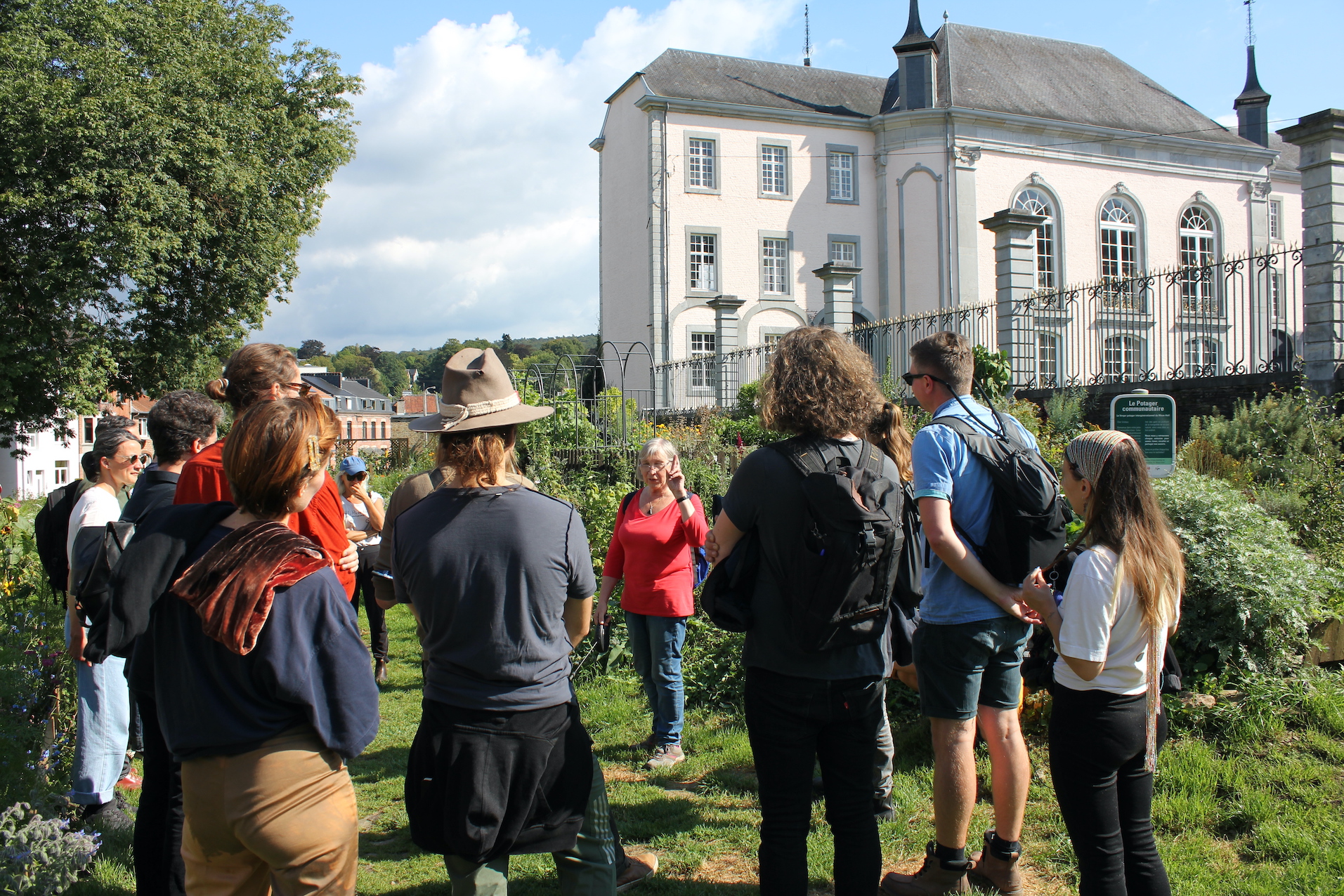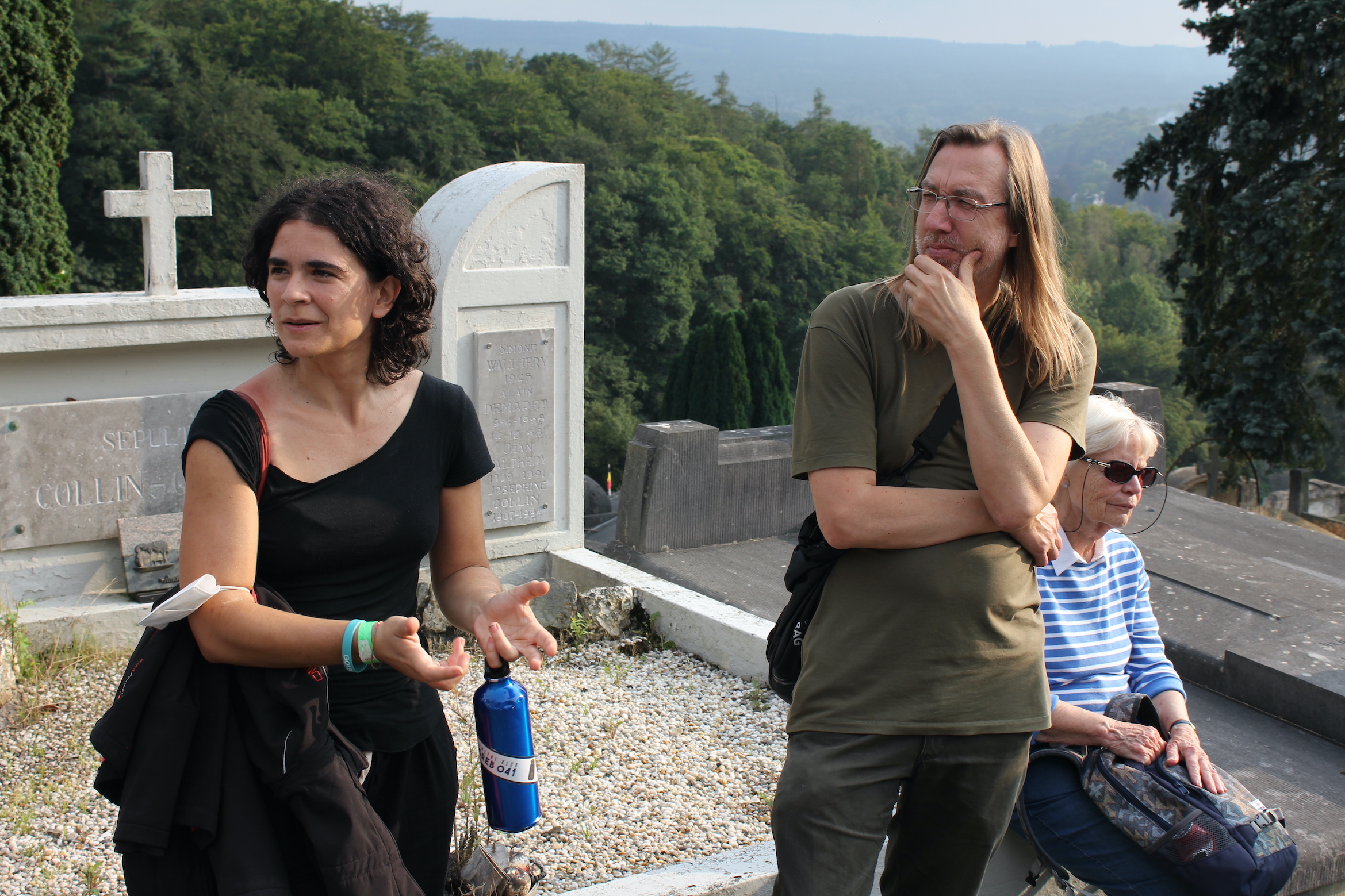7 WALKS (resolution), 2021
Part of the research project 7 Walks
Vermeir & Heiremans in collaboration with David Aubin, Steyn Bergs, Maria Francesca De Tullio, Françoise Jurion, Luke Mason, Anne Pirard, William Scott Raby, Christoph Rausch, Marie-Christine Schils, Julie Van Elslande, Jens Van Lathem and Tobias Van Royen.
7 Walks is a transversal project that aims to contextualize local practices of ownership in a broader social, legal and political reading. With walking as its performative methodology, 7 Walks consists of site-specific instalments that connect the ecology of the arts with a natural commons – water.
7 Walks (resolution) performed 10 public walks in the ‘therapeutic landscape’ around the thermal city of Spa. This instalment of the project allowed the artists, guests and participants to link questions of value with those of governance. The walks were informed and complemented by a documentary exhibition at the Musée de la Ville d’eaux, a Cabinet de lecture with archival documents and maps that offered an historical and socio-economic context for the walks.
The city of Spa became renowned for its ferruginous springs as early as the 16th century. Their medicinal waters not only attracted many visitors, they were also exported internationally. Gradually the city became the so-called ‘Café de l’Europe’. Visited by kings and czars, political refugees, artists and philosophers, it was a peaceful haven where a wide range of philosophies, social questions and artistic visions could be discussed. The ‘bobelins’, as the locals used to call these international visitors, walked through the surrounding forests, along landscaped paths on their way to the springs. They came to see and be seen, for diplomacy or espionage, and even for the arts. The local painter Antoine Fontaine depicted these illustrious visitors in his Livre d’Or (1894), a 9 metres wide group portrait spanning four centuries of visitors such as tsar Peter the Great, Voltaire, Joseph II, Descartes, Victor Hugo, Wellington, Farnese…
7 Walks (resolution) draws inspiration from the intangible legacy of historical walkers and invites its participants to explore a balance between private property of and access to resources that we hold in common as a society. Spa offers the project the unique opportunity for a series of itinerant reflections on water and art.
The project responds to current and recently intensified debates about the necessity and position of art in today’s society. Like water, art can be considered a basic necessity of life, a proposal that many international resolutions have promoted. The project questions how basic human rights enter into dialogue with individual private property rights and exclusive use rights.
From the 18th century, in addition to drinking water, walks in the woods surrounding Spa became part of the spa treatment that the town offered its visitors. Many trails are named after its international visitors, some of whom had strong views on property relations. 7 Walks (resolution) focuses on two of them, who are particularly emblematic and opposed in their contrasting conception of property, art dealer Ernest Gambart and political philosopher Pierre Joseph Proudhon. These two protagonists are historical cases that can trigger discussions on contemporary issues of monopolization and mutualisation.
The Cabinet de lecture that was set up in close collaboration with the museum, documents Gambart’s and Proudhon’s presence in Spa, as well as the use of the water sources and the development of a thermal city. 10 public walks, including a series of workshops, activated the documentary presentation. Vermeir & Heiremans were joined by guest walkers David Aubin, Steyn Bergs, Maria Francesca De Tullio, Françoise Jurion, Anne Pirard, Scott William Raby, Christoph Rausch, Marie-Christine Schils, Julie Van Elslande, Jens Van Lathem and Tobias Van Royen.
Local participants also engaged in the discussions. They came to the foreground with their own narratives, archive materials and experiences and in a way became co-creators of the walks rather than mere participants.
WALKING PROGRAMME
10-19 September 2021
Walk#01_THE SOCIAL FUNCTION OF ART
Promenade de 7 Heures – thermal baths – Hôtel d’Irlande – Pavillon Léopold II
Friday 10 September 2021
7 Walks (resolution) draws inspiration from the legacy of four centuries of water exploitation. This walk through the city center introduced a number of its central sources and former visitors. They all have walked the city promenades and enjoyed drinking the ferruginous water. Its built environment, monuments and even the street names link the city to its ‘intangible heritage’, the ideas of philosophers, politicians and artists who lived and walked these places. These historic residents of Spa had quite different ideas on the social function of art and on the governance of common resources. Apart from Tsar Peter the Great we come across painters Louis Gallait who worked with Ernest Gambart, but also Gustave Courbet, about whom philosopher Pierre Joseph Proudhon wrote extensively in his book The Principle of Art and its Social Destination (1865). Courbet was exemplary of the social purpose the philosopher reserved for the arts.
Walk#02_A CYCLE OF NATURAL AND ARTISTIC VALUES
Fagne de Malchamps – Promenade des Artistes – Source des Artistes
Saturday 11 September 2021
Spa became renowned for its medicinal water as early as the 16th century. The city embodies a history of four centuries of exploitation of springs which deliver ferruginous water with curative properties and, later, table water. This walk took us to the origins of the water, the Fagne de Malchamps. The morphology of the Fagne (‘peatland’) creates conditions for generous rainfall that is absorbed by the soil. It is the start of a long journey before the water resurfaces in one of the sources that surround the city. Walking towards the Fagne via Promenade des Artistes, we reach the Source des Artistes and one of the water capture points of Spa Monopole. As this promenade is conceived as a 19th century artificial landscape, it needs special care for its specific form to be preserved as part of the city’s heritage. Stepping in the footsteps of those who came before invited a reflection on the ecology of art and the water.
Walk#03_GAMBART’S MONOPOLY ON ARTISTS
Source Géronstère – Promenade Meyerbeer – Chateau d’Alsa
Sunday 12 September 2021
One of the most illustrious 19th century residents of the city of Spa was the art dealer Ernest Gambart. Before settling in Spa, Gambart’s London business unquestionably pioneered the commercial gallery system as is still in use today. He amassed his fortune by monopolising access to ‘his’ artists. After selling his business Gambart came to live in the Château d’Alsa in Spa where he nurtured his public image of a generous maecenas, inviting artists to come and take the waters at Spa. His art collection in his villa was considered one of the best of Europe at the time, the perfect setting to which to invite kings, queens, diplomats,… who then attended parties in the landscaped gardens of the estate.
Walk#04_CHATEAU D’ALSA, THE “VILLA SOLEIL DES ARTISTES”
Villa Hoctaisart – Promenade De Walque
Monday 13 September 2021
The art dealer Ernest Gambart came to live in the Château d’Alsa in Spa, a villa with several outhouses, that was situated in a lavish garden. Château d’Alsa was a real museum. It functioned as the luxurious backdrop against which he entertained a social elite who attended his weekly summer parties and receptions. He generously invited artists, musicians, singers and actors to stay in his villa and organised musical soirees to establish himself as maecenas and show his disinterested love for the arts. His villa in Spa quickly became renowned and was described in the press as the ‘villa soleil des artistes’. After his death the estate was cut up in multiple properties, some of which became ruins (villa Hoctaisart), other were refurbished and became a guest house (New Castle) or apartments (Chateau d’Alsa).
Walk#05_BRANDING THE WATER
Promenade d’Orléans – Source Sauvenière – Pouhon des Artistes
Tuesday 14 September 2021
The Source Sauvenière is one of the oldest sources in Spa. It was already mentioned in 1559 in the treatise of Gilbert Lymborh, describing the medicinal qualities of its waters. The Duchess of Orléans drank its water and regained her health which added to the fame of the Spa waters. By the middle of the 18th century, the city had acquired an enormous prestige which attracted ever more foreign aristocrats and wealthy visitors. Spa residents scornfully described them as ‘Bobelins’ (idiots), but in reality, these ‘Bobelins’ became the backbone of a local economy that was characterised by the tensions between the hospitality and the export business. The question of the authentication of Spa water was always a main concern. ‘Spa’, the name of the city, became a famous brand name, only to be used by those entrepreneurs that had an exploitation licence of the city.
Walk#06_A NATURAL OR ARTISTIC LANDSCAPE?
Source Pia – Source Géronstère – Promenade Meyerbeer – Source Barisart
Wednesday 15 September 2021
Walking in the forest to one of the sources south of the city only became fashionable in the course of the 19th century. The English landscape garden was the main inspiration for the walking trails which the mayor Servais developed in 1862: Promenade des Artistes, Promenade d’Orléans and Promenade Meyerbeer. Named after the German-born composer Giacomo Meyerbeer, this walking trail took us from Source Barisart all the way up to Source Géronstère. Although it looks like a natural landscape, we discovered numerous elements that were actually designed and built as visual references to the operas of Meyerbeer. Sculpted from nature the Promenade Meyerbeer raises questions that reveal the opposing interests that play out in the preservation of nature as art, or art as nature.
Walk#07_CAPTURING WATER FROM THE ARTISTS’ SOURCE
Promenade des Artistes – Pouhon Delcor – Promenade Cherville
Thursday 16 September 2021
The city of Spa and its forests inspired many artists in the 19th century. The Promenade des Artistes was dedicated to them. The trail was inaugurated in 1849. It follows the valley of the Picherotte, a small stream that runs down from the wooded hills. At the beginning of the trail we find one of the many capture points of Spa Monopole, the company that has been bottling and exporting the communal mineral waters since 1921. A discussion on common property and use rights of the waters extended here to the right to immaterial goods and services, like the arts.
Walk#08_A CONSPIRACY OF EQUALS IN SPA?
Promenade Deschanel – Balmoral – Promenade Arago
Friday 17 September 2021
Mid 19th century Belgium was hospitable to many French political refugees. Among them we find Emile Deschanel, Etienne Arago, Pierre Joseph Proudhon, Victor Hugo, Jules Hetzel, Henri Rochefort, Edgar Quinet and others. They found a friend in journalist Felix Delhasse who hosted many of them in Spa. Delhasse was part of the secret society La Charbonnerie and was a disciple of its founder Filippo Buonarotti. Buonorotti’s text ‘The History of the Conspiracy of Equals’ related the failed coup of Grachus Babeuf in 1796. Babeuf rejected the notion that equality before the law itself was sufficient to define societal equality, and thus placed a strong emphasis on the abolition of private property and on equal access to food. We walked the promenades dedicated to Arago, Deschanel and Hetzel and ended our walk in Rue Delhasse.
Walk#09_A MONUMENT TO THE CREATORS OF WALKS
Source Broxhou – Chemin Reikem – Promenade Berkely
Saturday 18 September 2021
In the 18th century, next to drinking measured amounts of water from specific sources, walking became part of the cures that were offered in Spa. Most of these walks originated in meadows close to the city center, where the ‘bobelins’ assembled at certain hours of the day. From the 18th century foreign visitors, like Berkely, contributed to the walking practices in Spa by laying out and financing the creation of walking paths in the northern hills overlooking Spa. In the 19th century many walks were created in the southern forests. In the Parc de 7 heures a monument is dedicated to the ‘Creators of Walks’. Our walk took us via Chemin Reickem to the Source Broxhou, one of the so-called lost sources in the woods surrounding Spa. We continued to the cemetery of Spa, where we found the monument for mayor Servais who created promenades in the southern hills. We returned via a promenade dedicated to Berkely, the designer of the first walking trail in Spa.
Walk#10_PIRACY AND COMPETITION
Source Prince de Condé – Sources Wellington, Tonnelet and Marie Henriette
Sunday 19 September 2021
During four centuries there was a fierce competition to gain a monopoly on the exploitation of the sources of Spa. Our walk took us to the Source Prince de Condé. Digging a hole in his basement, the owner of the building siphoned off water from the source Peter the Great. From there we walked to the abandoned source Wellington, an early competitor of the Compagnie Fermière des eaux de Spa, Spa Monopole’s predecessor. In 1921 that company gained exclusive exploitation rights of the city, as well as the licence to run the thermal baths and the exclusive right to us the name of the city to brand its bottled water. A short distance from Wellington we pass by Source Tonnelet and Source Marie-Henriette, sources that provide the mineral water for the thermal baths, former and current.
CABINET DE LECTURE
Musée de la Ville d’eaux
28 August – 14 November 2021
The walking programme was complemented by a Cabinet de lecture at the Musée de la Ville d’eaux, an exhibition of documents, artefacts and maps sourced from the museum and the Albin Body archive. The exhibition owes its inspiration and name to the 19th century cabinets de lecture in Spa that were run by the local bookseller-publisher Bruch-Marechal. These were furnished with forbidden books mainly by French publisher Jules Hetzel. In that way censured books by Victor Hugo, Proudhon and many others were available to select groups of readers.
The Cabinet de lecture consisted of four vitrines each with a selection of original documents, related to mutualising or monopolizing practices regarding the governance of the arts and water. A selection of copied books and leaflets were also available for public consultation, as well as a video slideshow on the life and work of Ernest Gambart. Next to a selection of historical maps that visualised the documents in the vitrines, Vermeir & Heiremans integrated a large-scale print out of the city of Spa and its environment sourced from Openstreetmap. On this print the 10 walks were drawn.
One of the most illustrious 19th century residents of the city of Spa was the art dealer Ernest Gambart. Before settling in Spa, Gambart’s London business unquestionably pioneered the commercial gallery system as is still in use today. A slideshow video and documents elaborate on Gambart’s creation of a market for living artists, his inventive and monopolising use of artists contracts, copyrights and exhibition rights, his new lifestyle as a Maecenas in Spa and his fight against piracy of artistic copyright. Read more….
Vitrine #02_Liberty, Equality, Justice. And Property?
Mid-19th century Belgium was hospitable to many French political refugees. They found a friend in journalist Felix Delhasse, a citizen of Spa, who hosted many of them in the thermal city. Proudhon, a refugee from the French justice system in Brussels, was also present in Spa. While he appreciated the forest, the city of Spa represented for him a kind of hell where the rich spent the money “which does not belong to them”, an idea found also in his principal work, What is Property? Proudhon’s mutualism did not advocate the abolition of property, instead he wanted to abolish the privilege that he believed property grants to its owners. Spa was the setting for a strong movement towards democracy and human rights. Documents from the Congress of Polleur relate to the creation of a Declaration of the Rights of Man and the Citizen in 1789, including the right to property. Read more….
Vitrine #03_Water Sources in Spa
Four centuries of water management form the basis for a series of ambulant reflections on water and art. The initial exploitation of the water sources had a medicinal purpose. Spa was the first to export its sparkling water to nearby regions and then across the whole of Europe, thereby proliferating the growing reputation of its cures. Its healing qualities were promoted in numerous publications since the 16th century, bringing the European nobility to Spa to ‘take the waters’. In the 19th century the city of Spa tried to give the exploitation of the sources in concession. In 1921 a monopoly on the exploitation of the municipal springs was granted to Spa Monopole: the contract between the city and the company stipulated the exploitation of the thermal baths and the water sources, and the right to use the name of the city as a brand: Spa. Read more….
Maps with detailed information on Spa and its environment were produced since the 16th century. Those maps helped to brand the waters as an asset, as they were printed in ‘guide books’, that were published by physicians, writing both on the health properties of the water and about Spa as a tourist destination. Map making also served the company Spa Monopole, branding their water products on Spa tourist maps. Other maps outlined ‘enclosures’, the protection zones around the sources that restrict the activities of other users of the water sources and the forests. Recent maps were produced that mark area’s with Unesco status, showing the different uses of the land and property ownership. Next to these historical maps a newly printed Open Street Map marked ten itineraries for the project. Read more….
7 WALKS (resolution)
Vermeir & Heiremans in collaboration with David Aubin, Steyn Bergs, Maria Francesca De Tullio, Françoise Jurion, Anne Pirard, Scott William Raby, Christoph Rausch, Marie-Christine Schils, Julie Van Elslande, Jens Van Lathem and Tobias Van Royen.
Photography Michael De Lausnay, David Houbrechts
Co-production Musée de la Ville d’eaux (Spa), Jubilee (Brussels) and Westminster University (London). Supported by the Flemish Community and by the Fédération Wallonie-Bruxelles (Un Futur pour la Culture).
Blueprint
A film by Justin Bennett
Blueprint is a 33-minute film that combines hand-drawn animated city maps and stenciled texts with a live soundtrack.
Each time Blueprint is screened, it is interpreted anew by live musicians. The musicians follow rules and suggestions developed in close collaboration with a number of improvisers, including the Amsterdam-based MAZE ensemble and Barcelona-based Atolón. Within the performance, there are no restrictions on instrumentation or genre.
Blueprint asks questions to the musicians and the audience regarding the links between social, urban and musical structures, work, creativity and freedom. The drawings in the work are based on maps of real cities and different types of urban growth from around the world.
The version below was performed by MAZE ensemble during the exhibition Blueprint / Seism (2015) at Gemak in Den Haag. The performance was filmed by Melissa Cruz Garcia & Hannah Dawn Henderson.
Watch the trailer of Blueprint on Vimeo
Blueprint was realized with the support of Jubilee, Stroom Den Haag, Mondriaan Fonds, Galerie Maurits van der Laar, Pascale-Sophie Kaparis and Marie-Jeanne de Rooij.
Presentations to date:
Maze Festival, film screening with live music at Splendor, Amsterdam (2016)
The Cost of Wealth, research residency and public programme, screening at World Trade Center Tower I, Brussels (2015)
Blueprint | Seism, experimental exhibition project at Gemak, The Hague (2015)
Justin Bennett (UK) Pascale-Sophie Kaparis (F), duo exhibition at Galerie Maurits van de Laar, The Hague (2014)

